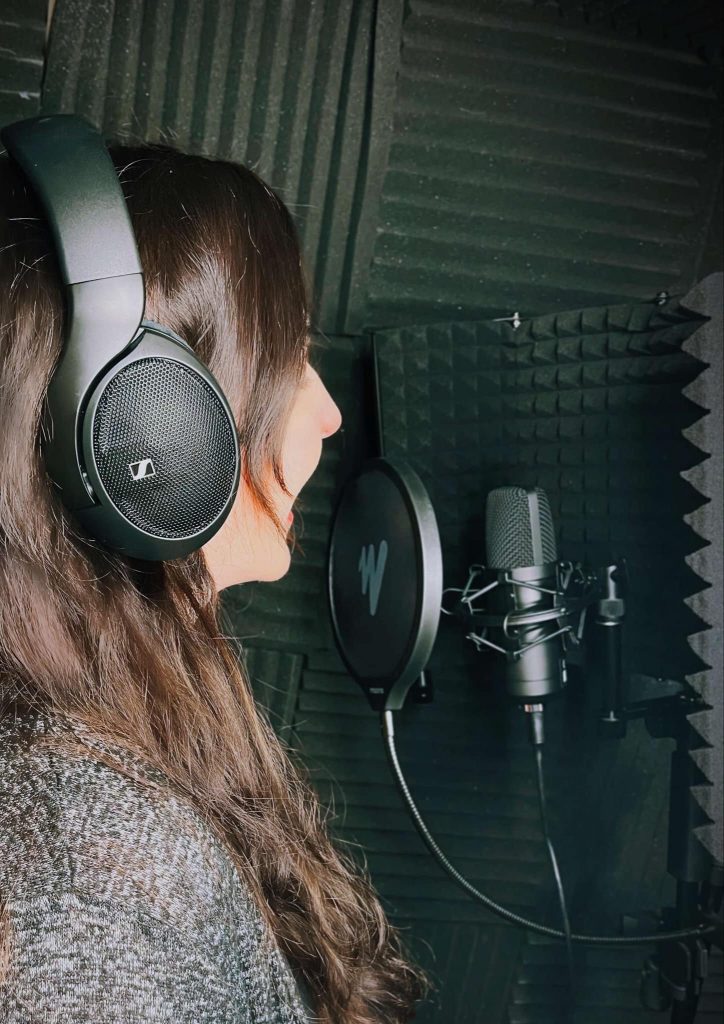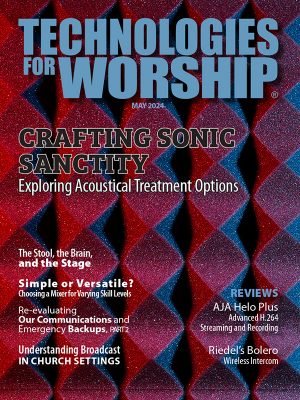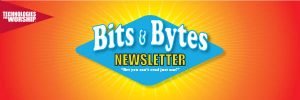
By Adriaana Corkum
Do you ever hear music in your mind, like whispers of a song that hasn’t been written yet? I always have. Melodies and lyrics seem to emerge from nowhere, weaving themselves together in quiet moments. Sometimes, I’ve written them down; other times, I’ve sung them aloud, letting the notes vanish as quickly as they came.
When I gave birth to my son in January, these moments became something more. Long nights rocking with my precious baby gave me endless hours to sing. It started as lullabies—soft, simple tunes—but before long, I was improvising songs for him, telling little stories through music. I didn’t expect anything to come of it; it was just a way to stay awake, to connect with my son, and to give voice to something I’ve always had hidden within myself. But as the weeks passed, I began to wonder: what if I could give these songs a life beyond my voice? Could they be transformed into something more lasting, something I could share? With no formal training in composition or music theory, I decided to experiment with the tools I had. What started as an exploration quickly became a journey of faith and creativity.
The Role of Technology in Music Creation
Technology became the bridge between my inspiration and execution. It opened doors I never knew existed and empowered me to create music in ways I couldn’t have imagined. If you’re a worship musician or ministry leader considering creating your own music, these tools could open similar doors for you. Let me take you through the ones I use most frequently and how they’ve transformed my creative process.
Vochlea: Transforming Melodies into Instruments
Vochlea Music’s Dubler 2 is the cornerstone of my composition process. For those unfamiliar, this software allows you to hum or sing melodies and converts them into MIDI data in real time. MIDI is essentially digital sheet music, and with Vochlea, it can mimic nearly any instrument.
Here’s how I use it:
- Recording Melodies: I sing directly into Vochlea using a microphone. The software captures the pitch, rhythm, and dynamics of my voice.
- Instrument Mapping: I assign the melody to an instrument, like piano or strings. Vochlea’s flexibility lets me experiment—transforming a hummed tune into a violin section or a synthesized bass line.
- Refinement: After the initial recording, I edit the MIDI data in GarageBand or Audacity to fine-tune the arrangement, ensuring it aligns with the vision of the song.
For worship musicians who already play instruments, this tool can complement your skills. Imagine sketching out a full orchestral arrangement with your voice, then refining it with your bandmates. Vochlea removes barriers, turning inspiration into tangible sound with astonishing ease.
GarageBand: The Foundation of the Song
Once the MIDI files are ready, I import them into GarageBand, a versatile digital audio workstation (DAW). GarageBand is user-friendly and ideal for beginners, but it’s also powerful enough for more advanced creators.
Here’s how I use it:
- Layering Tracks: I add multiple tracks, layering vocals, harmonies, and instrumental lines created in Vochlea.
- Adding Loops and Effects: GarageBand offers a library of loops—pre-recorded musical snippets—that I use to add depth and texture to the songs. Reverb, echo, and EQ tools help me refine the sound.
- Experimentation: This is where the magic happens. I test arrangements, adjust tempos, and mix in new elements until the song feels complete.
For worship musicians with access to full bands, GarageBand can become your central hub for collaboration. Band members can record their parts individually, and the software makes it easy to blend them seamlessly.
Fadr and LANDR: Polishing the Final Product
After recording and arranging, the tracks need to be polished to professional quality. This is where Fadr and LANDR come in.
- Fadr is a mixing tool that allows me to adjust volume levels, balance instruments, and ensure the overall track sounds cohesive. It’s intuitive, even for someone without a background in audio engineering.
- LANDR is a mastering platform that elevates the final mix, ensuring the music is clear and dynamic. It’s especially helpful for those of us working from home studios, as it simulates professional mastering environments.
These tools ensure that even with limited equipment, the final product is ready to be shared confidently.
Moises: Learning from the Greats
One of the most surprising tools in my creative arsenal is Moises, an app originally designed for isolating vocals and instruments from existing songs. While it’s a phenomenal resource for practice and study, its versatility extends far beyond its initial purpose. For worship musicians, Moises offers invaluable features that can enhance both preparation and live performance.
Here’s how I use Moises:
1. Isolating Instrumentation: Moises allows me to separate individual tracks—vocals, basslines, percussion, or strings—from recorded songs. This makes it easier to study how each element contributes to the overall arrangement, helping me learn new techniques for my own compositions.
2. Analyzing Vocals: By isolating the vocal track, I can study phrasing, harmonies, and lyrical delivery, drawing inspiration for how I approach vocal arrangements and lyric-writing.
But Moises isn’t just about analysis; it’s also a creative powerhouse:
3. Creating Unique Instrumental Tracks: Moises enables users to generate instrumental-only versions of songs, which can be particularly useful for worship bands. If a church doesn’t have the proper instrumentation for live performances—such as a full band or specific instruments like drums or strings—Moises can create instrumental tracks that the congregation can sing along to. These backing tracks can be adjusted to fit different tempos or keys, ensuring they’re accessible for any group or vocalist.
For example, if your church’s worship team lacks a guitarist but loves a song that relies heavily on guitar, Moises can produce a high-quality instrumental version of the song, removing the need for live accompaniment. This feature empowers smaller or resource-limited worship teams to bring the richness of contemporary worship music into their services.
This ability to adapt and create is a game-changer for worship ministries. Moises transforms the challenge of limited resources into an opportunity for innovation, ensuring that the music—and the message behind it—remains the focus. Whether you’re refining your skills, studying arrangements, or creating tracks for live use, Moises is a tool that bridges gaps and expands possibilities, allowing your worship to shine no matter the circumstances.
Listen to Adriaana’s Easter album, Love & Sacrifice, on all streaming platforms
Creativity as Worship
Using these tools has shown me that creativity itself is a form of worship. While I can play instruments like piano, guitar, and some concert band staples (trombone, clarinet, etc.), my confidence lies in singing. These tools have allowed me to work around my limitations, transforming my voice into an orchestra. For worship musicians with instrumental skills, the possibilities are even greater.
This journey is about more than music; it’s about connecting people to the Bible in new ways. My current project—a concept album about Christ’s Passion and resurrection—aims to explore the humanity within scripture. Each song will tell the story of a different figure, from Mary’s heartbreak to Peter’s regret, grounded in their emotions and perspectives.
I dream of these songs being used in Passion Plays, Stations of the Cross, and Easter liturgies, helping others feel the weight of these sacred moments. For worship musicians, I hope my process inspires you to explore your own creative potential. With these tools, your music can become a unique offering of faith and artistry.
Building a Home Studio: A Commitment to Creativity
Embarking on this musical journey required not just time and inspiration, but also a dedicated investment in creating a space where my ideas could come to life. With limited room in my house, I had to get creative, ultimately transforming a small linen closet in my basement into a recording studio. It’s far from luxurious, but with a few thoughtful adjustments, this tiny space has become the heart of my creative process.
Here’s how I made it work:
Transforming the Closet into a Studio:
The linen closet, previously a storage space for extra towels and bedding, was cleared out and repurposed into a makeshift recording booth. To improve acoustics, I lined the walls with foam panels to reduce echo and sound reflections. An audio blanket was draped across one wall to further dampen outside noise. These additions created a controlled environment perfect for recording, even in a small, unconventional space.
Essential Equipment:
Microphone and Mic Stand: A condenser microphone was the first major purchase for the studio. It’s designed to pick up clear, detailed audio, which is especially important for capturing vocals. A sturdy mic stand ensures the microphone stays secure during recordings.
Audio Mixer: I invested in a mixer to adjust audio levels and fine-tune recordings in real time, ensuring a polished sound even before editing begins.
Software and Editing Tools:
Audacity: This free software has been a game-changer. With its ability to remove unwanted background noise and clean up recordings, it helps bridge the gap between a small linen closet and a professional studio. Its layering and effects capabilities allow me to experiment with harmonies and instrumental arrangements.
Empowering Churches with Existing Resources
For worship musicians and church ministries, setting up a similar space might be easier than you think. Many churches already have access to some of the necessary equipment:
• Microphones and Mic Stands: Most worship teams use these regularly for services, so there’s no need for additional investment.
• Mixers:: Churches often have audio mixers as part of their sound systems, making it easy to capture high-quality recordings.
• Recording Space: A quiet room or chapel can serve as a suitable recording environment. Adding foam panels or portable acoustic shields can improve the acoustics without requiring a complete makeover.
By leveraging these existing resources, churches can create their own unique worship music or even produce recordings of sermons, prayers, or special performances for the congregation.
Audacity: Free and Powerful
One of the best parts of this process has been discovering how much can be accomplished with free tools like Audacity. For churches or individuals on a tight budget, Audacity offers incredible functionality without cost. Its noise reduction feature is particularly useful for recordings made in less-than-ideal conditions, and its ability to layer tracks, add effects, and fine-tune audio ensures professional results.
By combining tools like Audacity with equipment many churches already own, worship teams can create music that reflects their unique vision and sound. The investment in creativity doesn’t have to be a financial burden—it can be about making the most of what’s already available.
A Testament to Commitment
Building my home studio has been a labor of love, one that reflects my dedication to this journey of faith and music. For churches, the process might look a little different, but the outcome is the same: an opportunity to create music that uplifts, inspires, and connects. Whether you’re starting with a full suite of tools or just a microphone and a free program, the important thing is to start. Let the music lead, and trust that what you create will touch hearts in ways you never imagined.
Looking Ahead: The Journey Continues
1. This article marks just the beginning of an exciting series that will take you through the heart of my creative process. While today’s piece has focused on laying the groundwork—sharing my journey, tools, and vision—the next three articles will dive deeper into the specifics of how these songs come to life.
2. The Next Article: Crafting an Album
In the second article, I’ll take you behind the scenes of the creation process for my concept album centered on Christ’s Passion and resurrection, and how your Worship Bands and ministries can do the same. I’ll detail how the lyrics were developed, exploring the stories and characters of the Bible that inspired them. We’ll discuss the melodies—how they took shape, what emotions they aim to evoke, and how I used tools like Vochlea and GarageBand to turn these ideas into recordings. I’ll share the specific steps I followed, from sketching out ideas to building foundational tracks, and why certain artistic choices were made. For worship musicians, this will serve as a blueprint for translating inspiration into tangible songs.
3. The Third Article: Polishing the Sound
The third and final article in this series will focus on the post-production process, where raw recordings are transformed into polished pieces. This includes everything from mixing and mastering to selecting the right effects and adjusting audio levels. I’ll discuss how tools like Audacity, LANDR, and Fadr were used, the specific settings applied, and the reasoning behind each choice. Whether you’re fine-tuning vocals or creating seamless instrumental tracks, this article will provide practical insights that worship bands and churches can use to create professional-sounding recordings of their own.
4. The Final Article: Sharing Your Masterpiece
In the fourth, and final article, I’ll guide you through creating a unique sound for your group or solo project and sharing it with a wider audience. We’ll explore how to craft distinctive musical calling cards using tools like Kits.AI, GarageBand, and Moises, and discuss distribution methods to get your music on platforms like Spotify and YouTube. I’ll also cover music publishing basics, branding strategies, and how to craft a message that resonates with listeners. Finally, we’ll dive into utilizing social media to promote your music and engage your community, providing you with the tools to create, share, and grow your music ministry effectively.
A Resource for Worship Bands and Ministries
The goal of this series isn’t just to share my journey but to empower others to embark on their own. By breaking down each stage of the process, I hope to provide worship bands and churches with a practical guide to creating unique and meaningful music. Whether it’s writing lyrics that resonate with your congregation, crafting melodies that uplift the spirit, or refining recordings for services, these articles will offer tools and inspiration to make it possible.
This journey is an invitation to explore how faith and creativity can come together in powerful, transformative ways. Each article will build on the last, culminating in a roadmap that any musician—novice or experienced—can follow to share their own stories and songs.
Join the Journey
As this series unfolds, I hope you’ll join me on this exploration of music, faith, and storytelling. Together, we’ll delve into the art and craft of creating music that celebrates the sacred, reflects the human experience, and brings scripture to life in new and meaningful ways. Whether you’re looking for inspiration, technical tips, or simply a shared love for creativity and worship, this series is for you.
The road ahead is full of melodies waiting to be discovered. Let’s walk it together, one song at a time!
Adriaana Corkum is a music educator with a Bachelor of Music in Vocal Performance, a Bachelor of Education, and a Master of Education specializing in STEAM and lesson planning. A devoted wife and new mother, Adriaana finds inspiration in her family to share her passion for music and her voice with others.







